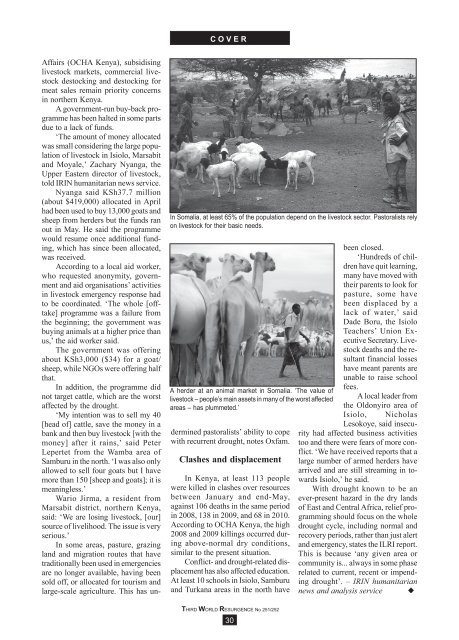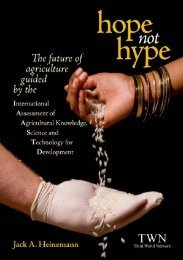The Editors - Third World Network
The Editors - Third World Network
The Editors - Third World Network
You also want an ePaper? Increase the reach of your titles
YUMPU automatically turns print PDFs into web optimized ePapers that Google loves.
C O V E R<br />
Affairs (OCHA Kenya), subsidising<br />
livestock markets, commercial livestock<br />
destocking and destocking for<br />
meat sales remain priority concerns<br />
in northern Kenya.<br />
A government-run buy-back programme<br />
has been halted in some parts<br />
due to a lack of funds.<br />
‘<strong>The</strong> amount of money allocated<br />
was small considering the large population<br />
of livestock in Isiolo, Marsabit<br />
and Moyale,’ Zachary Nyanga, the<br />
Upper Eastern director of livestock,<br />
told IRIN humanitarian news service.<br />
Nyanga said KSh37.7 million<br />
(about $419,000) allocated in April<br />
had been used to buy 13,000 goats and<br />
sheep from herders but the funds ran<br />
out in May. He said the programme<br />
would resume once additional funding,<br />
which has since been allocated,<br />
was received.<br />
According to a local aid worker,<br />
who requested anonymity, government<br />
and aid organisations’ activities<br />
in livestock emergency response had<br />
to be coordinated. ‘<strong>The</strong> whole [offtake]<br />
programme was a failure from<br />
the beginning; the government was<br />
buying animals at a higher price than<br />
us,’ the aid worker said.<br />
<strong>The</strong> government was offering<br />
about KSh3,000 ($34) for a goat/<br />
sheep, while NGOs were offering half<br />
that.<br />
In addition, the programme did<br />
not target cattle, which are the worst<br />
affected by the drought.<br />
‘My intention was to sell my 40<br />
[head of] cattle, save the money in a<br />
bank and then buy livestock [with the<br />
money] after it rains,’ said Peter<br />
Lepertet from the Wamba area of<br />
Samburu in the north. ‘I was also only<br />
allowed to sell four goats but I have<br />
more than 150 [sheep and goats]; it is<br />
meaningless.’<br />
Wario Jirma, a resident from<br />
Marsabit district, northern Kenya,<br />
said: ‘We are losing livestock, [our]<br />
source of livelihood. <strong>The</strong> issue is very<br />
serious.’<br />
In some areas, pasture, grazing<br />
land and migration routes that have<br />
traditionally been used in emergencies<br />
are no longer available, having been<br />
sold off, or allocated for tourism and<br />
large-scale agriculture. This has un-<br />
In Somalia, at least 65% of the population depend on the livestock sector. Pastoralists rely<br />
on livestock for their basic needs.<br />
A herder at an animal market in Somalia. ‘<strong>The</strong> value of<br />
livestock – people’s main assets in many of the worst affected<br />
areas – has plummeted.’<br />
dermined pastoralists’ ability to cope<br />
with recurrent drought, notes Oxfam.<br />
Clashes and displacement<br />
In Kenya, at least 113 people<br />
were killed in clashes over resources<br />
between January and end-May,<br />
against 106 deaths in the same period<br />
in 2008, 138 in 2009, and 68 in 2010.<br />
According to OCHA Kenya, the high<br />
2008 and 2009 killings occurred during<br />
above-normal dry conditions,<br />
similar to the present situation.<br />
Conflict- and drought-related displacement<br />
has also affected education.<br />
At least 10 schools in Isiolo, Samburu<br />
and Turkana areas in the north have<br />
been closed.<br />
‘Hundreds of children<br />
have quit learning,<br />
many have moved with<br />
their parents to look for<br />
pasture, some have<br />
been displaced by a<br />
lack of water,’ said<br />
Dade Boru, the Isiolo<br />
Teachers’ Union Executive<br />
Secretary. Livestock<br />
deaths and the resultant<br />
financial losses<br />
have meant parents are<br />
unable to raise school<br />
fees.<br />
A local leader from<br />
the Oldonyiro area of<br />
Isiolo, Nicholas<br />
Lesokoye, said insecurity<br />
had affected business activities<br />
too and there were fears of more conflict.<br />
‘We have received reports that a<br />
large number of armed herders have<br />
arrived and are still streaming in towards<br />
Isiolo,’ he said.<br />
With drought known to be an<br />
ever-present hazard in the dry lands<br />
of East and Central Africa, relief programming<br />
should focus on the whole<br />
drought cycle, including normal and<br />
recovery periods, rather than just alert<br />
and emergency, states the ILRI report.<br />
This is because ‘any given area or<br />
community is... always in some phase<br />
related to current, recent or impending<br />
drought’. – IRIN humanitarian<br />
news and analysis service u<br />
THIRD WORLD RESURGENCE No 251/252<br />
30

















